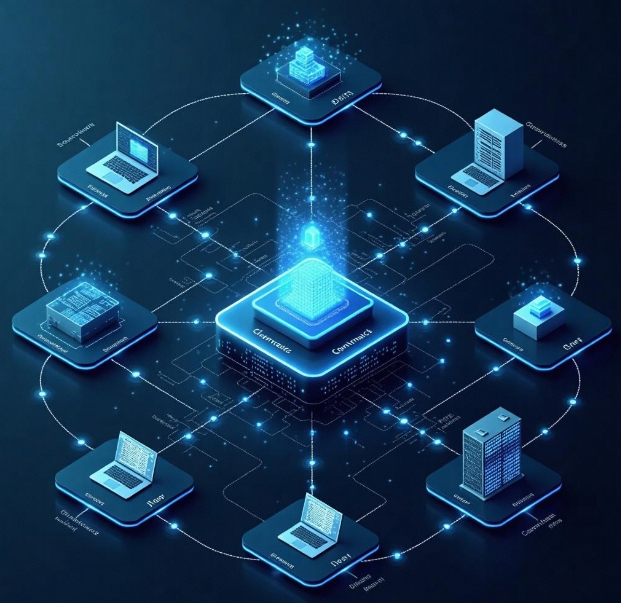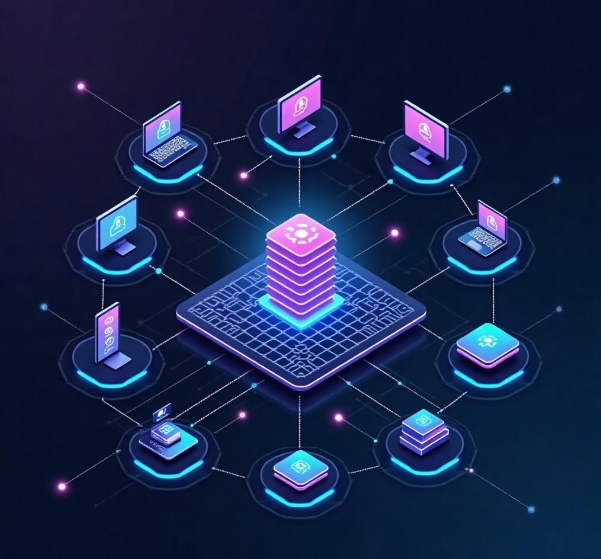API Interface and Blockchain Network Integration in DApp Development
- latest articles
- 1.DApp Development & Customization: Merging Diverse Market Needs with User Experience 2.Analysis of the Core Technical System in DApp Project Development 3.How to achieve cross-chain interoperability in Web3 projects? 4.How does the tokenization of points reconstruct the e-commerce ecosystem? 5.How to Set and Track Data Metrics for a Points Mall? 6.What is DApp Development? Core Concepts and Technical Analysis 7.Inventory of commonly used Web3 development tools and usage tips 8.Development of a Distribution System Integrated with Social E-commerce 9.Six Key Steps for Businesses to Build a Points Mall System 10.What is DApp Development? A Comprehensive Guide from Concept to Implementation
- Popular Articles
- 1.Future Trends and Technology Predictions for APP Development in 2025 2.Analysis of the DeFi Ecosystem: How Developers Can Participate in Decentralized Finance Innovation 3.From Zero to One: How PI Mall Revolutionizes the Traditional E-commerce Model 4.DAPP Development | Best Practices for Professional Customization and Rapid Launch 5.Recommended by the Web3 developer community: the most noteworthy forums and resources 6.From Cloud Computing to Computing Power Leasing: Building a Flexible and Scalable Computing Resource Platform 7.How to Develop a Successful Douyin Mini Program: Technical Architecture and Best Practices 8.Shared Bike System APP: The Convenient Choice in the Era of Smart Travel 9.How to Create a Successful Dating App: From Needs Analysis to User Experience Design 10.From Design to Development: The Complete Process of Bringing an APP Idea to Life
In the development of modern blockchain applications, decentralized applications (DApps) are increasingly favored by developers and enterprises. DApps (Decentralized Applications) utilize blockchain technology to achieve functions such as data storage, transaction recording, and smart contracts, featuring decentralization, transparency, and security. Developing DApps requires not only a solid foundation in blockchain knowledge but also an understanding of how to efficiently interact with blockchain networks, particularly in integrating API interfaces with blockchain networks. This article will delve into how API interfaces can be effectively integrated with blockchain networks during DApp development and analyze key technical implementations.
I. Introduction to DApps
Decentralized applications (DApps) are applications developed based on blockchain networks, with decentralization as their core characteristic, meaning they do not rely on traditional centralized servers for data storage and computation. The frontend of a DApp is similar to traditional applications, typically built on web technologies (HTML, CSS, JavaScript, etc.), while the backend is processed based on blockchain smart contracts and decentralized storage.
The operation of DApps depends on blockchain networks, with common platforms including Ethereum, EOS, Tron, and NEO. Smart contracts are the core of DApps; they are self-executing programs deployed on the blockchain that can automatically complete transactions and execute agreements based on specific rules.
II. The Role of API Interfaces in DApp Development
In the development process of DApps, APIs (Application Programming Interfaces) play a crucial role. The primary function of API interfaces is to facilitate interaction between the frontend application and the blockchain network. Through API interfaces, the frontend of a DApp can send requests to the blockchain network to retrieve on-chain data or submit transaction requests to smart contracts. Common API interfaces include the following:
1. Retrieving Blockchain Data
DApps need real-time access to data on the blockchain network, such as block information, transaction details, and smart contract execution results. API interfaces provide a simple way to obtain this information. Through APIs, developers can query data like the balance of a specific address, transaction history, and contract status, thereby offering users more personalized and immediate services.
2. Submitting Transactions to the Blockchain
Users of DApps often need to interact with the blockchain, such as sending transaction requests or executing smart contracts. API interfaces are typically responsible for converting user transaction requests into a format recognizable by the blockchain network and broadcasting them to the network via nodes. When performing these operations, developers must ensure transaction signatures and data integrity to prevent malicious attacks or errors.
3. Interacting with Smart Contracts
Smart contracts are a vital component of DApps, containing the application's business logic. API interfaces not only help the frontend interact with smart contracts for data exchange but can also call functions within the contracts. For example, users can use APIs to invoke specific functions of a smart contract to perform operations like asset transfers, voting, or payments.
III. Challenges in Integrating API Interfaces with Blockchain Networks
Although API interfaces provide a bridge for DApps to interact with blockchain networks, integrating APIs with blockchain networks faces many challenges in practice. Below are some common challenges and their solutions.
1. High Latency in Blockchain Networks
One characteristic of blockchain is decentralization, which makes the transaction validation process slower compared to traditional centralized servers. Each node in the blockchain must validate transactions, and confirmation through mining or consensus mechanisms is required. This can result in high latency for DApp API interfaces, affecting user experience.
Solutions:
Use Asynchronous Requests: For operations that do not require real-time feedback, asynchronous requests can mitigate the impact of latency on user experience.
Caching Mechanisms: For frequently queried data, caching can be implemented in the DApp frontend or backend to reduce access to the blockchain network.
Use Layer 2 Solutions: Technologies like sidechains or lightning networks can reduce transaction confirmation times and improve API response speeds.
2. Complexity of Blockchain Data
Data on the blockchain is typically encrypted and stored in a chain structure. Developers need to parse blockchain transaction data, block data, etc., through API interfaces. This parsing and processing may require additional effort, especially with large data volumes or frequent queries, potentially leading to performance issues.
Solutions:
Data Storage: Consider storing blockchain data in external databases as needed, periodically synchronizing the latest data from the blockchain to avoid on-chain queries every time.
Optimize Data Access: Use techniques like paginated queries or distributed queries to enhance data access speed.
3. Security Issues
The openness of blockchain exposes DApps to higher security risks. For example, hackers might attack API interfaces to steal users' private keys or funds. As the intermediary between DApps and the blockchain, API interfaces can become weak points if not properly secured.
Solutions:
Use Encrypted Communication: All API requests and responses should be encrypted using HTTPS to prevent man-in-the-middle attacks.
Use Signature Mechanisms: Ensure that transactions submitted to the blockchain are signed by legitimate users and not forged.
Restrict API Access: Control who can access the DApp's API interfaces using mechanisms like API keys or OAuth to prevent unauthorized access.
4. Differences Between Blockchain Platforms
API interface implementations may vary across different blockchain platforms, especially when DApps need to support multiple platforms, increasing development complexity. Each blockchain platform has different protocols, data structures, and transaction formats.
Solutions:
Abstract API Interfaces: Design a unified API interface layer to hide the specific implementations of different blockchain platforms, allowing developers to interact with various platforms using the same interface.
Use Third-Party Services: Platforms like Alchemy and Infura offer cross-chain API services, enabling developers to interact with multiple blockchains through their APIs.
IV. How to Implement API Interface Integration Between DApps and Blockchain
1. Choose the Right Blockchain Platform
Before integrating API interfaces, developers need to select a suitable blockchain platform based on the DApp's requirements. Different platforms have different advantages and characteristics. For example, Ethereum supports smart contracts and decentralized applications, making it suitable for DApps requiring complex smart contracts, while lightweight platforms like NEO and Tron may be better for high-frequency transaction applications.
2. Use Web3.js or Ethers.js
Ethereum is one of the most popular blockchain platforms, and Web3.js and Ethers.js are two commonly used JavaScript libraries that help developers integrate API interfaces with blockchain networks. Web3.js provides interfaces for interacting with Ethereum nodes, supporting operations with smart contracts, accounts, and transactions; Ethers.js is a lighter library offering a more concise API.
3. Connect to Blockchain Nodes
To interact with the blockchain, DApps need to connect to a blockchain node. Developers can choose to set up their own nodes or use third-party services like Infura and Alchemy. Infura and Alchemy provide highly available node services supporting API interfaces for multiple blockchains like Ethereum, allowing developers to interact with the blockchain without maintaining their own nodes.
4. Integrate Smart Contracts
Smart contracts are the core of DApps, and developers need to call smart contract functions through API interfaces, which can be accomplished using Web3.js or Ethers.js.
5. Use IPFS for Data Storage
Due to the limited data storage capacity of blockchains, developers often store large amounts of data in distributed file systems like IPFS (InterPlanetary File System). IPFS can be integrated with DApps via API interfaces to store user-uploaded data or external data required by smart contracts.
V. Summary
In DApp development, integrating API interfaces with blockchain networks is crucial. API interfaces not only help developers connect the frontend to the blockchain but also enable access to blockchain data, transaction submission, and smart contract interactions. However, integrating APIs with blockchains faces challenges such as high latency, security vulnerabilities, and platform differences. Developers need to address these issues through techniques like asynchronous requests, caching mechanisms, and encrypted communication, while selecting appropriate blockchain platforms and tool libraries to achieve efficient and stable integration.
As blockchain technology evolves, the integration of API interfaces with blockchain networks will become simpler and more efficient, enabling future DApps to provide users with more convenient, secure, and rich decentralized application experiences.
-

DApp Development & Customization: Merging Diverse Market Needs with User Experience
As blockchain technology matures and becomes more widespread, decentralized appl···
-

Analysis of the Core Technical System in DApp Project Development
With the rapid development of blockchain technology, decentralized applications ···
-

What is DApp Development? Core Concepts and Technical Analysis
With the rapid development of blockchain technology, decentralized applications ···

 Blockchain
Blockchain












